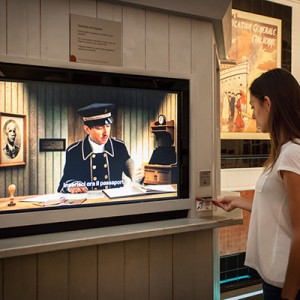Storytelling, Gamification, Interactivity: a new Museum Experience
Best Practice SessionDavide Pantile, Italy , Emanuele Di Rosa, Italia, Roberto Frasca, Italia, Matteo Ventrella, Italia, Giovanni Verreschi, Italia
This paper will focus on ETT’s application of multimedia tools to successfully use the gamification concept in cultural heritage, in order to support “museum’s storytelling”.
Our ICT company has gained experience by looking at museums in a new way, creating an immersive visitor experience, and using innovative technologies to increase visitor engagement and interaction. ETT has achieved this by developing an engaging gamification model using tools such as high-resolution monitors, interactive touch-screen interfaces, 3D reconstructions, proximity sensors, gaming simulations, augmented reality and interactive projections with on-screen actors. By presenting visitors with a series of simulations and “challenges”, they become less “visitor” and more “actor”: “visit-actors”, an active part of the “story” told by the museum. In this paper we’ll show some significant examples of how we achieved these results.
The first installation of this type was at the Galata Sea Museum in Genoa (Italy) where ETT created a multimedia pre-show of the Nazario Sauro submarine. Visit-actors “enrol” in the submariners’ school, use touch screen interfaces to learn about shipboard life and instruments (periscope, hydrophone, etc.) and take simple tests to earn a “submariner diploma”.
A full “immersive journey” into the story is the central idea of Galata Museum section on Memory and Migration. More than forty multimedia stations focus on the history of migration and immigration up to the present day. Visitors receive a coded passport and are put into the shoes of nineteenth / twentieth century emigrants about to sail to the Americas on an ocean liner, interacting with virtual characters.
This “enjoyment” approach has been applied to scientific topics such as archaeology. The Sestri Levante Museum has installed “Excavate and Learn”: a mock dig simulates an archaeological excavation experience, which transforms visitors into archaeologists, and let objects to “tell” their history. The project was selected as a best practice at the recent Digital Heritage international conference held in Marseilles in November 2013.
A significant example of storytelling “outside the museum” is given by Liguria Heritage augmented reality mobile app, which supports the visit of various historical points of interests on Liguria region territory. Through the mobile app, tourists can meet, in an avatar form, characters involved in the historical events of these places and learn – from them – about the cultural heritage.
Our latest “frontier” is multi-sensory experience. In the “4D Storm Chamber”, recently opened at the Galata Museum, visit-actors experience the intense emotion of being shipwrecked off Cape Horn, on board a moving lifeboat at the mercy of stormy seas. There are high resolution 3D wrap-around video screens, the sounds of sea and wind, and sea spray.
By constantly adopting new technologies, as they become available, and through careful use of the most suitable and sustainable technologies for each project, ETT has increased visitor involvement by making museums fascinating. All age groups are catered for, as well as experts in specific fields, and the story told by the museum reaches everyone. Results are visitor appreciation, visitor number growth and international awards.




